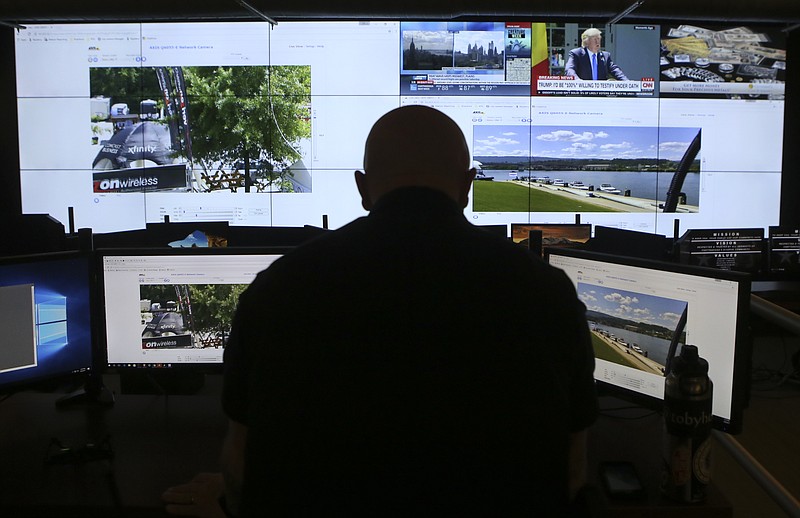The Chattanooga Police Department's real-time intelligence center is up and running and has already played an instrumental role in securing the arrests of four gang members allegedly involved in the Thursday night shooting of an 8-year-old boy.
Chattanooga police Chief Fred Fletcher said Friday morning that vital video footage routed directly into the center allowed officers to identify a suspect vehicle in that shooting - a perfect example of the center's current and future capabilities.
"The ability to put these bad guys in jail, where they belong, so quickly, did not happen by accident. It did not happen overnight," Fletcher said.
"Because of crime data, public safety cameras, community and witness cooperation and officer intelligence, your Chattanooga police officers swiftly identified the coward who shot a little boy."
Alberta Marshall was riding in a white van with her son in the backseat on Windsor Street around 8 p.m. when a suspect, later identified as 28-year-old Lebron Brown, aka "2G," approached the van and allegedly shot multiple times into it, striking the boy in his abdominal area, according to court records. The boy was still listed in critical condition Friday morning.
"I can't even begin to imagine the fear and horror that that mom experienced at that moment," Fletcher said. "As your police chief and your neighbor, I cannot begin to express how angry I am that there are people in our community with such little [regard] for life.
"Nothing pisses off cops like bad guys who harm children."
Officers working nearby heard the gunfire and responded, locating several .40-caliber PMC brand shell casings on the 2100 block of Windsor Street.
A witness in the area told police they saw the shooting and followed the suspect vehicle, a black Nissan Rogue, to the 1400 block of Carousel Road. Officers responded, surrounded the home and secured the car.
Officers saw a black male drop a gun out a window, which turned out to be a .40-caliber pistol. Five men, one of whom was Brown, were then pulled out of the home and taken into custody.
Officers were also told that Brown was living at a home on Windsor Street near the shooting and were given consent to search the home by its owner. In one of the rooms, they found a half-full box of .40-caliber PMC bullets and several pieces of mail addressed to Brown.
The homeowner told police Brown lived in that room and all the items were his. The homeowner's son also said he was outside when the shooting occurred and saw Brown shoot into the van before fleeing in a black SUV that was parked next door.
Also arrested on unrelated charges were Dedrick Lindsey, 23; Khavell Williams, 22; and Darious Woods, 22.
"Lindsey has been arrested by our officers previously for a shooting. In fact, your officers put Lindsey in jail in 2011 for shooting a man," Fletcher said. "Lindsey got out, then was charged with shooting the same man again earlier this year. He went to jail again and has bonded out."
"Because of his involvement with [Thursday] night's shooting federal law enforcement agencies have now put a federal hold on Lindsey so that he cannot commit any more violence in the near future."
Footage caught by a camera at the Bayberry apartment complex, which was analyzed in the intelligence center shortly after the shooting, showed the suspect vehicle. And although witnesses' testimony is available, Fletcher said there is likely sufficient evidence to prosecute the case without them.
"We will very likely be able to prosecute these people without witnesses," he said. "We're very thankful to have witnesses, but because of the evidence and technology we have, we have the ability to do that."
The police department is in the midst of a two-year rollout of the intelligence center, which has been put together and expanded incrementally since July of last year.
"This is basically modern policing," said Sgt. Billy Atwell, who is in charge of the center. "Where violent offenses occur most often, that's where we've put those cameras."
In February, the Chattanooga City Council approved $750,000 in cameras, software and video networking tools for the center. A portion of that totaling $137,905 was for a contract for 15 pole-mounted cameras and networking software and a $250,000 agreement to install a video monitor wall at the police service center.
As was the case in Thursday's shooting, relevant footage can be useful to investigators looking for supplementary evidence. Atwell said he was able to pull up the footage and identify the suspect vehicle just minutes after one of the responding officers described it to him.
"My phone started ringing, I picked up my laptop and logged on," he said. "He didn't realize it at the time, but witnesses described it to him and he remembered passing that vehicle when he was going there."
Elisa Myzal, communications coordinator for the police department, said video footage can have extraordinary evidentiary value, especially when victims or witnesses are unwilling to talk to police because they fear retaliatory violence.
"It's reliable, accurate, unbiased testimony," she said.
The center has proven useful in other ways, as well. For instance, analysts stationed there have access to a constant stream of reported incidents that allow them to identify trends.
"Within three minutes of it being reported, it's imported into our system," Atwell said.
One of the analysts, Katherine Hill, said an analyst is assigned to each of the three sectors they oversee and they write daily reports for officers on all the incidents called in. The flood of information can also be subdivided into incident types - one analyst, Jennifer Bagget, writes a daily briefing on shots fired and shootings.
"She writes the intel daily - if there were shells found, suspect description," Hill said. "You're giving a synopsis. Just a quick glance."
That information is then reported to officers who can use it to better focus resources where everything from car burglaries to homicides are happening. It's unclear how many cameras might be deployed in the future, but they would be installed in other determined hotspots.
But having access to an endless flood of incident reports isn't always enough. Analysts already have a lot of clay to work with, but the information they receive, and the data officers have to work with, is reliant on civilians calling in incidents.
"That's why it's important for people to report things," Myzal said.
Having more eyeballs on the street is helpful, but unless an incident is reported, it won't be fed into the intelligence center and included in the department's analysis.
Fortunately, Fletcher said, more and more people are starting to cooperate with police by reporting and actually talking to police when they arrive. He said the willingness of witnesses to speak about what they saw in Thursday's shooting is an example of the progress the department has made with the community.
"Put bad guys in jail and keep them in jail, and people will stand up and tell their communities they won't allow it," he said.
Contact staff writer Emmett Gienapp at egienapp@timesfreepress.com or 423-757-6731. Follow him on Twitter @emmettgienapp.

